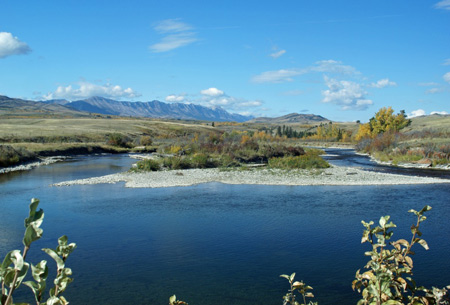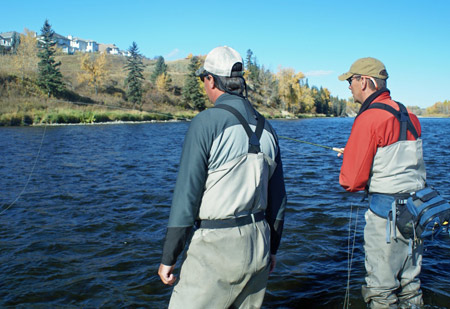|
 |
| Nymphing is perhaps the most productive method for fly fishing rivers and streams. | As summer reaches its apex many lower elevation lakes slip into the summer doldrums, leaving anglers looking for other fly fishing challenges. One of the most readily available opportunities are the numerous rivers and streams that weave their way across the province. While perhaps not as famous as other regions of North America, British Columbia still offers some world-class river and stream fishing.
Many anglers I know seek out rivers and streams as a remedy for their dry fly cravings. Indeed moving water is the dry fly fisher’s paradise. But more often our visits to rivers sees little or no hatch and consequently the dry fly action is tough at best. Early on in the summer season rivers still tend to be swollen from spring run off, especially this year. As it is inefficient to rise up through deep swift water trout prefer the security and calm of back eddies, sunken debris and boulders trout waiting to ambush their dinner as the current drifts it by. The solution is simple, if the trout won’t come up to eat, go down and get them by bouncing nymphs on or near the bottom.
My set up for fishing nymphs is simple and adaptable so if the hatch magically appears I can be working the surface in a matter of minutes, usually its just a matter of changing flies. I prefer fly rods in the 3 to 5 weight range, the smaller the stream and its residents the lighter the rod. For just about my entire nymph fishing a floating line in conjunction with a 12-foot leader fits the bill. Beginning with a standard 9-foot leader tapered to 3x I knot on a three-foot tippet section of equal or smaller diameter. This method allows for a long thin tippet that cuts through the water, speeding up the sink rate of the fly while putting it in the feeding zone quicker and longer. The double surgeons knot serves as a quick reminder for a tippet change while maintaining a consistent leader length.
 |
| Using a strike indicator or dry fly as an indicator helps detect takes. | Other aids to the nymph fishers tackle bag include split shot and strike indicators. For the fly fisher who do not tie flies split shot becomes important to drag the pattern down to the depths in the absence of a weighted fly. Even if the fly is weighted some water conditions such as pocket water or swift riffles dictate a heavy setup. While controversial to some strike indicators can be essential at times, especially for the novice nymph fisher. Trout reject non-food items including flies in the blink of an eye. Strike indicators give the angler a visible clue signaling a take. If the indicator pulls under, slows or moves upstream set the hook. It might be a rock or a sunken log but it’s surprising the number of times it’s a trout. This approach might seem costly on the fly budget but that’s the price for successful nymph fishing. Indicators help control depth too making sure the fly ticks naturally along the bottom. A good rule of thumb is to set the indicator at about twice the water’s depth. This means constant indicator adjustment throughout the day, often from run to run. Some of my favorite indicator materials included corkies, yarn, and Bio Strike putty. Be sure to check local regulations for each river or stream to make sure weight on the leader and indicators are permitted.
To view the rest of this article, please login or join now for free!
|



